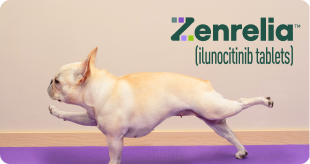Dormosedan
Prescription required.
Prescription required.


What is Dormosedan?
Dormosedan is indicated for use as a sedative and analgesic (pain reliever) to facilitate minor surgical and diagnostic procedures in mature horses and yearlings. It has been used successfully for the following: to calm fractious horses, to provide relief from abdominal pain, and to facilitate bronchoscopy, bronchoalveolar lavage, nasogastric intubation, non-reproductive rectal palpations, suturing of skin lacerations, and castrations. Additionally, an approved, local infiltration anesthetic is indicated for castration. Dormosedan requires a prescription from your veterinarian.
Suitable For:
Horses
Benefits:
- Sedative and analgesic to facilitate minor surgical and diagnostic procedures
- Predictable and effective
- Significant analgesia extending more than 15 minutes post administration
- Non-narcotic sedation with a wide margin of safety
How does Dormosedan work?
Dormosedan is an a2 adrenoceptor agonist that provides non-narcotic sedation and analgesia that can be used safely in horses for a variety of minor surgical and diagnostic procedures. The greater a2 selectivity of Dormosedan allows it to bind specifically to a2 adrenoceptors to produce predictable and effective sedation and analgesia.
Cautions:
IMPORTANT SAFETY INFORMATION: Do not use DORMOSEDAN GEL in horses with pre-existing atrioventricular (AV) or sinoatrial (SA) block, with severe coronary insufficiency, cerebrovascular disease, respiratory disease, or chronic renal failure. Do not use in anesthetized or sedated horses, or in conditions of shock, severe debilitation or stress due to extreme heat, cold, fatigue or high altitude. Do not use in horses intended for human consumption. Handle gel-dosing syringes with caution to avoid direct exposure to skin, eyes or mouth.
Brand Name:
Dormosedan (Zoetis)
Generic Name:
detomidine hydrochloride
What is the most important thing I should know about Dormosedan?
Dormosedan is indicated for use as a sedative and analgesic to facilitate minor surgical and diagnostic procedures in mature horses and yearlings. It requires a prescription from your veterinarian. Dormosedan is a potent a2-agonist, and extreme caution should be exercised in its use with other sedative or analgesic drugs for they may produce additive effects. When using any analgesic to help alleviate abdominal pain, a complete physical examination and diagnostic work-up are necessary to determine the etiology of the pain. Food and water should be withheld until the sedative effect of Dormosedan has worn off.
What should I discuss with my veterinarian before giving Dormosedan to my pet?
Tell your veterinarian if you're planning on breeding your horse or if your mare is pregnant or lactating. Consult with your veterinarian if your horse is currently using any sedatives or analgesics. Let your veterinarian know if your horse has a hypersensitivity to detomidine hydrochloride or other sedatives or analgesics.
How should Dormosedan be administered?
Dormosedan vials should be administered intramuscularly or intravenously and Dormosedan Gel should be administered sublingually (below the tongue of the horse). Syringe is not included. Follow your veterinarian's instructions exactly as directed. Before administration, careful consideration should be given to horses approaching or in endotoxic or traumatic shock, to horses with advanced liver or kidney disease, or to horses under stress from extreme heat, cold, fatigue, or high altitude. Protect treated horses from temperature extremes. Some horses, although apparently deeply sedated, may still respond to external stimuli. Routine safety measures should be employed to protect practitioners and handlers. Allowing the horse to stand quietly for 5 minutes before administration and for 10-15 minutes after injection may improve the response to Dormosedan. The gel must be placed beneath the tongue of the horse, and it is not meant to be swallowed. One 3 ml dosage of Dormosedan Gel provides dosage for up to 1,210-1,320 lbs body weight.
What are the potential side effects of Dormosedan?
Occasional reports of anaphylactic-like reactions have been received, including 1 or more of the following: urticarial (hives), skin plaques, dyspnea, edema (swelling) of the upper airways, trembling, and recumbency (leaning/lying down). Reports of mild adverse reactions have resolved uneventfully without treatment. Severe adverse reactions should be treated symptomatically. Horses treated with Dormosedan exhibit hypertension. Bradycardia (slow heart action) routinely occurs 1 minute after injection. The relationship between hypertension and bradycardia is consistent with an adaptive baroreceptor response to the increased pressure and inconsistent with a primary drug-induced bradycardia. Piloerection (bristling of hairs), sweating, salivation, and slight muscle tremors are frequently seen after administration. Partial transient penis prolapse may be seen. Urination typically occurs during recovery about 45-60 minutes post treatment, depending on dosage. Incoordination or staggering is usually seen only during the first 3-5 minutes after injection, until animals have secured a firm footing. Because of continued lowering of the head during sedation, mucus discharges from the nose and, occasionally, edema of the head and face may be seen. Holding the head in a slightly elevated position generally prevents these effects.
What happens if I overdose my pet on Dormosedan?
Dormosedan (detomidine hydrochloride) is tolerated in horses at up to 200 mcg/kg of body weight (10 times the low dosage and 5 times the high dosage). In safety studies, detomidine hydrochloride at 400 mcg/kg of body weight administered daily for 3 consecutive days produced microscopic foci of myocardial necrosis in 1 of 8 horses.
What should I avoid while giving Dormosedan to my pet?
Protect treated horses from temperature extremes. Food and water should be withheld until the sedative effect of Dormosedan has worn off.
What other drugs will affect Dormosedan?
Dormosedan is a potent a2-agonist, and extreme caution should be exercised in its use with other sedative or analgesic drugs for they may produce additive effects. The use of epinephrine should be avoided since epinephrine may potentiate the effects of a2-agonists.


Dormosedan Directions:
- Follow your veterinarian's instructions exactly as directed.
- Administer Dormosedan Vials intramuscularly (IM) or intravenously (IV). Syringe not included.
- Administer Dormosedan Gel sublingually (beneath the tongue). It must be placed beneath the tongue of the horse and it is not meant to be swallowed.
- Food and water should be withheld until the sedative effect of Dormosedan has worn off.
Allowing your horse to stand quietly for 5 minutes before administration and for 10-15 minutes after administration may improve the response to Dormosedan. Before and after injection, your horse should be allowed to rest quietly.
Dormosedan Dosage:
| Weight | Dosage |
|---|---|
| All weights | Administer Dormosedan at the rates of 20 or 40 mcg detomidine hydrochloride per kg of body weight (0.2 or 0.4 ml of Dormosedan per 100 kg or 22l lb), depending on the depth and duration of sedation required. Onset of sedative effects should be reached within 2-4 minutes after IV administration and 3-5 minutes after IM administration. Twenty mcg/kg will provide 30-90 minutes of sedation and 40 mcg/kg will provide approximately 90 minutes to 2 hours of sedation. Dormosedan Gel produces sedation when administered sublingually (beneath the tongue) at 0.0018 mg/lb. |
| Weight | Dosage |
|---|---|
| All weights | Administer Dormosedan IV at the rates of 20 or 40 mcg detomidine hydrochloride per kg of body weight (0.2 or 0.4 ml of Dormosedan per 100 kg or 220 lb), depending on the depth and duration of analgesia required. Twenty mcg/kg will usually begin to take effect in 2-4 minutes and provide 30-45 minutes of analgesia. The 40 mcg/kg will usually begin to take effect in 2-4 minutes and provide 30-45 minutes of analgesia. The 40 mcg/kg dose will also begin to take effect in 2-4 minutes and provide 45-75 minutes of analgesia. |
| Weight | Dosage |
|---|---|
| All weights | Administer Dormosedan IV at the rates of 20 or 40 mcg detomidine hydrochloride per kg of body weight (0.2 or 0.4 mL of Dormosedan per 100 kg or 220 lb), depending on the depth and duration of sedation and analgesia required. |
| Cats |
|---|
| Do not use! |
| Dogs |
|---|
| Do not use! |
Storage:
Store at a controlled room temperature out of the reach of children and pets.


Dormosedan Ingredients:
| Active Ingredient (per ml) | Amount |
|---|---|
| Detomidine hydrochloride | 10 mg/ml |
| Active Ingredient (per ml) | Amount |
|---|---|
| Detomidine hydrochloride | 7.6 mg/ml |











































